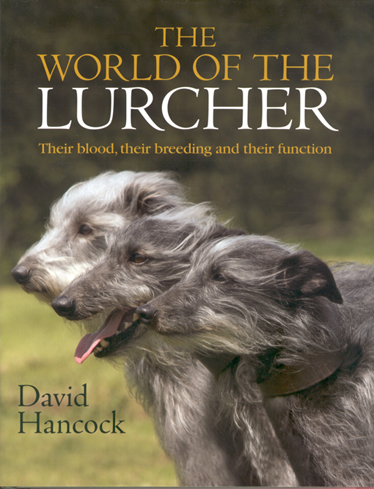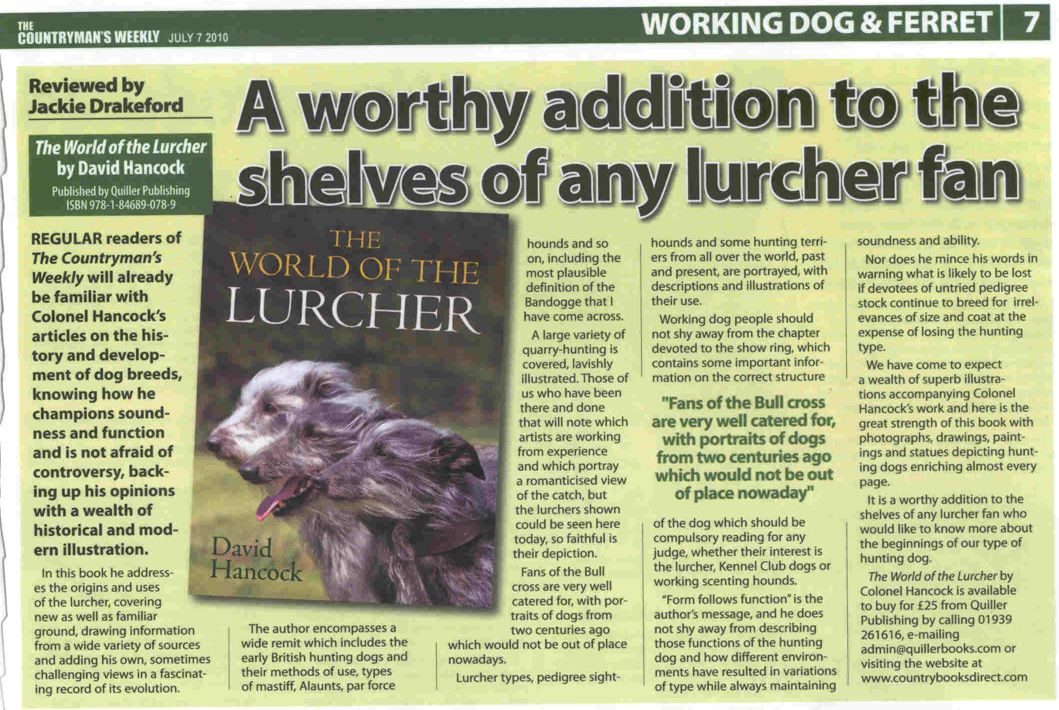THE WORLD OF THE LURCHERS by Colonel David Hancock |
THE WORLD OF THE LURCHER
by Colonel David Hancock
Dedication PrefaceIntroductionChapter 1 The Hunter’s Ultimate Performance Dog:
Chapter 2 Perfecting the Blend:
Chapter 3 Sources of Speed:- Hunting by Speed - The Saluki
Chapter 4 Fielding the Lurcher
Chapter 5 Lurcher Skills Overseas
Conclusion: Keeping the Faith
Glossary of Terms
THE WORLD OF THE LURCHER (Quiller, 2010) by David Hancock
BACK COVER/DUST COVER
This book, Colonel Hancock's eighth, is about lurchers, the hunting dog of the humbler hunters. It covers not just the origins, uses, structure, breeding advice, blend of breeds and foreign counterparts, but the wide patronage of these hybrid talented hounds. Lavishly illustrated, it covers many aspects of the lurcher scene for the very first time. It is not a manual dealing with feeding, training, health concerns and rearing. It is a book for the hunter, the person more interested in what the lurcher does. No previous book has covered comparable hunting dogs abroad so fully; no other book on lurchers evaluates so deeply the value of the breeds contributing to this hybrid hound. When reviewing one of his previous books, the country sports writer and lurcher expert, the late Brian Plummer, described it as 'a masterpiece'. A Canadian reviewer of another of his books, gave the view that Colonel David Hancock is 'perhaps the most important living writer about dogs'.
CONTENTS: SYNOPSIS
Introduction: The most numerous type of dog in Britain; rooted in working class breeders, long lacking in nobler patronage. Remarkable popularity of cross-bred sporting dogs, purity of breeding never revered by hunters. Effectiveness the only real test, the proven value of mixed blood.
Chapter 1: The Hunter's Ultimate Performance Dog: The origin and purpose of the lurcher, the hunting dog of the peasant and the poacher, now favoured too by the well-heeled, not just the farm labourer, with shows proliferating from sheer interest. The lurcher as a functional dog, from a blend of breeds, its anatomy allowing hunting prowess. The desire to hunt more important than physique. Essentials of breeding as set out by experts. Importance of ingredient/contributing breeds. Selection of breeding stock the key. Understanding genetics important. Heredity passed on randomly not mathematically. Dominant and recessive traits. Perils of too close breeding. Overuse of certain sires not wise.
Chapter 2: Perfecting The Blend: The value of collie blood: cleverness and obedience, sagacity ahead of speed, eagerness to work prized. The value of Deerhound blood: size, strength and coat, vital to match anatomy with terrain. The input of Bedlington Terrier blood: terrier persistence and waterproof coat, selection of breeding material the key. Use of bull lurchers is historic and specific; mastiff ancestry, bandogge role, hunting mastiff background. The coarsely-bred catch-dogs of the boar-hunt; boar-lurchers, complementary use with scenthounds, impact of Alauntes, role of different Alauntes, mastiff and bandogge functions. Big Greyhounds used as wolf-dogs, Irish and Russian breeds survive, medieval value proven.
Chapter 3: Sources of Speed: Hunting by speed, development of the sighthounds, deficiencies of show ring hounds, sighthound phenotype rooted in function. Impact of the Greyhound, remarkable pace from anatomical make-up. Gazehounds different from sighthounds; Greyhounds replicated abroad: Galgo, Chart Polski and Magyar Agar, supreme canine athletes. Desert sighthound, the Saluki: great stamina, long-distance sprinter, good feet, difficult to train, widespread use in North Africa and Middle East. The miners' Greyhound: the Whippet, amazing sprinters, tenacity from terrier blood, importance of heart and liver size and lung room, crucial role of sound shoulders; must be conserved as a sporting dog.
Chapter 4: Fielding the Lurcher: The show ring type. The need for schooling, handling and pre-show training, vital importance of condition. Lurchers must never be bred for show-stance ahead of pot-filling prowess, must not become canine film-stars. Rabbits have to be controlled; absence of specialist rabbit hound. Universal need for rabbit-culling; US style different. Difficult prey, can make a good hare-dog look stupid. Problems of using terriers with lurchers, value of Beagle blood. Scope for bobbery packs, using hounds and terriers together in packs, new role for the Airedale. Shows can never help selection of breeding material, best regarded as social gathering.
Chapter 5: Lurcher Skills Overseas: The desert sighthounds, often out-crossed, different types of Saluki: the Middle Eastern dog, Sloughi is the Arab dog, Azawakh is the African. Varying types of Indian lurchers. South African hunting dogs, remarkably robust, surviving harsh climate and testing terrain. Mediterranean littoral abounding with lurchers: Portugal, Spanish Islands, Malta and Gozo, Sicily and Crete, all bat-eared sighthounds of Tesem type. Are field trial regulations for lurchers needed here? Enormous scope of steppes for sighthound work, well-known Borzoi, unknown Chortaj, Tasy, Taigon and Circassian Greyhound. All used as lurchers on wide variety of quarry.
Conclusion: Keeping the Blood: Eternal role, certainty of catching game with hounds against likely maiming with guns. Loss of instinctive canine skills, threat of feral pig, value of lamping dogs. Remarkable survival of the lurcher down many centuries. Vital need to keep the blood alive.
|

